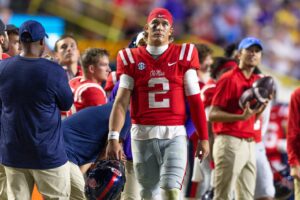Oklahoma and Texas leaving for the SEC has created a tsunami throughout the college sports landscape. It has caused both the casual fan and the long time sports pundits to be stumbling over themselves breaking down the rest of the Big XII conference to figure out who goes where in the college sports garage sale of the century. The fact that so many are missing critical details has turned the social media analysis into the Sanford and Son’s junkyard of memes. One message can be made clear for the Pac-12; Do not pick up the Big XII leftovers.
Oklahoma and Texas leaving the Bix XII for the SEC takes away the biggest value from the conference. Certainly the remaining schools tout their significance. Baylor is the NCAA men’s basketball champ. Kansas is a basketball blueblood. TCU is a good program. And, well, yeah, that is about that. The other schools are competitive in many sports.
So why does the Pac- 12 need to rush to stake a claim to any of the remaining Big XII schools? Exactly. It doesn’t.
Can The Big XII Be Saved?
First of all, the idea that the Big XII is dead man walking is short sighted. There is no replacing Oklahoma and Texas in terms of historical value and branding worth. But they can be replaced. Expect conference commissioner Bob Bowlsby to be calling Memphis, Cincinnati, SMU, and Houston in the coming days. All are good multi-sport programs, beginning with football. They are certainly better media markets than Norman, Oklahoma. And they would not stretch the current conference map beyond its current borders. The Big XII would actually have a dozen teams.
If that doesn’t work, then yes, the conference has no long-term future. There be the equivalent of a foreclosure auction for the remaining schools. West Virginia would likely look to be back with the ACC where it belongs anyway. Any combination of the two Kansas schools and Iowa State would look for a life raft from the Big Ten. And then who goes to the Pac- 12? The conference should say thanks, but no thanks.
The Pac-12 has been a highly flawed conference for many reasons and for many years. New commissioner George Kliavkoff has his hands full. If those we spoke to, upon his hiring, are correct he will turn over every rock to look at every opportunity for growth. This isn’t that.
Adding teams to the conference simply to make the number bigger does not mean you are keeping up with the SEC. In fact, you should not try to keep up with the SEC because that horse left the barn long ago.
What Is Next For Pac-12?
The biggest element for the conference in the coming years is the new TV rights negotiations. They will start in 2023 and likely conclude in 2024 with a start in 2025. They are everything to a conference whose schools are currently drowning in athletic department debt.
So here is where you start ticking off the list of Big XII schools, post conference meltdown. Is your TV package enhanced by adding Texas Tech and the Lubbock market? Manhattan, Kansas and the K-State Wildcats? Ames, Iowa and the Cyclones? Waco? It is easier to get a flight from Los Angeles to Killeen, Texas.
We know this is not 2011 where we are counting cable viewers, but the media market as an entity still matters. There is nothing to be gained by the Pac-12 feeling compelled to engage in arms race for what amounts to a bunch of participation trophies.
That is not to say the conference can’t expand, but it requires some creativity that everyone says Kliavkoff has, and not settling for picking off the dying conference.
Academics Are A Thing
First let’s discuss the elephant in the room. Go to your favorite college football social media site and you will see the names of Boise State, BYU, Baylor, and others thrown out there. Scratch them off the list. Boise State is a nice football program but brings nothing else to the table other than being really close to Washington State. It’s not a viable market, nor is it a blueblood that warrants us looking past its lack of media viability. The three aforementioned also share a common obstacle; academics. The Pac-12 requires that to gain admission to the conference, a school must be a Tier 1 research university as ordained by the Carnegie Classification of Institutions of Higher Education. Boise State, BYU, and Baylor fall short.
The commissioner, via the conference presidents and chancellors, has the ability to grant a waiver. But if they were going to do that for BYU they would have done it at the last expansion a decade ago. Granting the waiver needs to come with a stroke of creativity and greater purpose. Granting a waiver would be of value to say, SMU and TCU. For the sake of argument, we are going to add four teams and include Houston and Rice.
Market Viability Is A Thing
Before we get into the semantics and details, let’s break this down into something very simple. If Pac-12 fans are going to travel for a road game, do you think they choose Dallas, TX or Stillwater, OK? Houston, TX or Manhattan, Kansas?
SMU and TCU are competitive football programs as well as being strong nationally in several sports. They are both Tier 2 research schools, so they are not completely out on the fringe. And you know what they bring with them? Money and market size. TCU sits in the Dallas/Fort Worth market and SMU is in the heart of the Dallas Metroplex.
TCU’s Case
TCU is about to break ground on a $100 million stadium renovation for Amon G. Carter Stadium. It is the second $100+ million renovation for the stadium in a decade, because the financial backers are there. The stadium already far surpasses that of its blueblood neighbor in Austin. You know what else TCU has? Balanced books. A review of its 2019-2020 athletic department financial report shows it broke even. That puts it ahead of nearly every existing Pac-12 school. Imagine bringing in a school that is carrying its own weight as soon as it walks in the door.
![<a id='uOUahvWiTBxvsVJgvbwwgw' class='gie-single' href='http://www.gettyimages.com/detail/1065430514' target='_blank' style='color:#a7a7a7;text-decoration:none;font-weight:normal !important;border:none;display:inline-block;'>Embed from Getty Images</a><script>window.gie=window.gie||function(c){(gie.q=gie.q||[]).push(c)};gie(function(){gie.widgets.load({id:'uOUahvWiTBxvsVJgvbwwgw',sig:'viuTzyX4j20MZGDdE0KAxwKjXG1XZCjLF7Oi-W4iPRE=',w:'594px',h:'396px',items:'1065430514',caption: true ,tld:'com',is360: false })});</script><script src='//embed-cdn.gettyimages.com/widgets.js' charset='utf-8' async></script>](https://lastwordonsports.com/collegefootball/wp-content/uploads/sites/3/2021/07/Amon-G.-Carter-Stadium-4-1-e1627342529330.jpg)
SMU’s Case
SMU has a real-life billionaire as its primary athletic benefactor. Gerald J. Ford is the name outside the stadium because the banking/financial mogul paid $10 million for its original construction. His banking business also provides him with many west coast ties. He used to be chairman of Golden State Bancorp and was a resident of Beverly Hills. The stadium is due for an upgrade, and by reports we have from inside the SMU community, the money is there. It is simply waiting for a new green light. Ironically, Ford used to serve as a regent for Texas A&M, which is about to get screwed by Texas’ move to the SEC. Ford is only 5th in terms of the largest donors to the university so the school is well funded. And frankly, Sonny Dykes had a better year at SMU than 90% of the existing Pac-12 teams.
![<a id='uOUahvWiTBxvsVJgvbwwgw' class='gie-single' href='http://www.gettyimages.com/detail/1065430514' target='_blank' style='color:#a7a7a7;text-decoration:none;font-weight:normal !important;border:none;display:inline-block;'>Embed from Getty Images</a><script>window.gie=window.gie||function(c){(gie.q=gie.q||[]).push(c)};gie(function(){gie.widgets.load({id:'uOUahvWiTBxvsVJgvbwwgw',sig:'viuTzyX4j20MZGDdE0KAxwKjXG1XZCjLF7Oi-W4iPRE=',w:'594px',h:'396px',items:'1065430514',caption: true ,tld:'com',is360: false })});</script><script src='//embed-cdn.gettyimages.com/widgets.js' charset='utf-8' async></script>](https://lastwordonsports.com/collegefootball/wp-content/uploads/sites/3/2021/07/gettyimages-577086258-594x594-1.jpg)
Rice’s Case
Rice and Houston may sound like we pulled them out of left field, but if you believe that, you are not familiar with the Pac-12. The conference will always claim academics first and athletics second. Meet the Rice Owls of Houston, TX. It is one of the elite universities in the country. A GPA of 4.2 with a 35 ACT might have gotten you a look for 8% acceptance rate for the freshman class of 2021. What they lack in football history, they make up for elsewhere, including the 2003 College Baseball World Series championship. Think of them athletically as no worse than an Oregon State or Arizona, but in a more relevant media market and with better academics.
Rice University has a policy of not disclosing the amount of private donations, but they did just open a new $3 million, 80,000 square foot indoor athletic training facility.

Houston’s Case
The University of Houston appeases the conference leadership’s public-school fans. It is a Tier 1 Carnegie research school. It just completed a staggering $1.2 billion fundraising campaign. In its press release, the school said the money will be used to, “Build state-of-the-art facilities, attract and retain top faculty, advance academic programs, workforce training and research that fuel a healthy Houston economy, and build a nationally relevant athletics program.” Nationally relevant athletics, with new facilities, in a major market. That already puts it ahead of the Big XII leftovers. TDECU Stadium would be one of the newest stadiums in the Pac-12. While it seats 40,000 now, it has been configured and approved to expand to 60,000. And did we mention it is in a major metropolitan market with a lot of money?

Choosing Your Own Fate
The Pac-12 has suffered as an also-ran in the Power 5 conference conversation for too long already. Picking up another conference’s leftovers off the scrap heap does nothing to fix that perception. The college football playoff expansion is likely to be postponed, while the committee waits to see what dominos fall where. Create your own destiny with some creativity. Don’t wait for the Big XII to try to salvage itself by picking apart C-USA and the AAC. Make your own move and your own destiny. Move Utah and Colorado to the Pac- 12 North. Enjoy the new Pac- 16. Choose Dallas over Lubbock. Choose Houston over Ames. Go raid the state of Texas for recruiting. If you are going to expand, do it on your own terms for a change.






